- What does a debt fund invest in?
- How is these instruments dependent on interest rate changes?
- Effects of Interest rate changes on different categories of debt funds
- Interest Rate announcements in India in 2017
- Conclusion
What does a debt fund invest in?
Debt funds invest in securities offered by government and corporates. The issuer of the security pays an interest at a specific rate for a specified period (maturity) and the principal is paid back on maturity date. Such securities may be treasury instruments, corporates bonds or debentures. Securities issued by government are known as government securities or Gilts. All government securities are sovereign guaranteed and therefor assured to be AAA rated. In case of corporate bonds, the rating provided by rating agencies is critical and funds do not invest in corporate bonds rated lower than AA.
How are these instruments affected by interest rate changes?
The changes prices of securities are inversely proportional to changes in interest rates. So, if interest rates increase from current levels, the prices of bonds decrease and vice versa.
Let us assume, units of a debt fund were purchased at an NAV of ₹100 and coupon rate of 8% with a 10-year maturity. The interest payment on this is ₹8 per year. If the interest rate is now increased to 10%, the new bonds with a 10-year maturity will be more attractive. Thus, old bonds start trading below face value and NAV reduces to, let’s assume ₹90. The returns on them would be ₹8/₹90 giving a yield of 8.89%. Thus, as interest rates are increased, the bond prices fall and yield increases.
Similarly, if the interest rates are reduced from 8% to 6%, the existing bonds will be more attractive and will start trading above face value, let’s assume ₹110. The returns on the old bonds will be ₹8/₹110, giving a yield of 7.27%. Thus, as interest rates are reduced, the bond prices rise and yield decreases.
Interest Rate announcements in India in 2017
In India, the Reserve Bank of India reviews the monetary policy on a bi-monthly basis and formulates and announces the interest rate.
Going into 2017, India had seen interest rates cuts from 6.75% down to 6.25%
- February 2017 – RBI keeps the rate unchanged at 6.25%
- April 2017 – RBI keeps the rate unchanged at 6.25%
- June 2017 – RBI keeps the rate unchanged at 6.25%
- August 2017 – RBI cuts the rate to 6.0%
- October 2017 – RBI keeps the rate unchanged at 6.0%
- December 2017 – RBI keeps the rate unchanged at 6.0%
Effects of Interest rate changes on different categories of debt funds
The magnitude of change on bond prices will differ depending on the tenure of the bonds.
- Liquid Funds: Liquid funds are at the shortest end of the maturity spectrum and invest in debt instruments for up to 91 days. Thus, they are affected the least in case of interest rate changes.
Below is a one-year graph of ICICI Prudential Liquid fund. The graph is a smooth incline with no volatility in an economy with reducing interest rates in 2017 giving returns of 6.6%
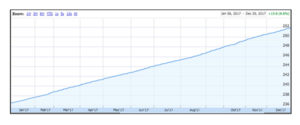 Figure 1: ICICI Prudential Liquid Fund
Figure 1: ICICI Prudential Liquid Fund
- Ultra-Short debt funds and Short-term debt funds: Ultra Short-term debt funds invest in bonds with a maturity date of up to 1 year whereas Short-term debt funds invest in bonds with a maturity date ranging from 1 to 3 years. These funds will perform better than Income funds, Gilt funds and Dynamic bond funds in a rising interest rate economy but not better than liquid funds. Although despite “better” performance, it can still mean fall in prices.
- Below is a one-year graph of ICICI Prudential Ultra Short-term fund. It is a stable incline with short periods of volatility in an economy with reducing interest rates in 2017, giving returns of 6.6%
 Figure 2: ICICI Prudential Ultra Short Term
Figure 2: ICICI Prudential Ultra Short Term
Below is a one-year graph of ICICI Prudential Short-term fund. It is a stable incline with short periods of volatility in an economy with reducing interest rates in 2017, giving returns of 5.9%. The volatility is higher than Ultra short-term funds.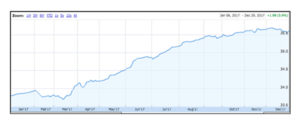 Figure 3: ICICI Prudential Short Term Fund
Figure 3: ICICI Prudential Short Term Fund
- Income funds, Gilt funds and Dynamic bond funds: Income funds invest in corporate bonds, government securities and money market instruments with a long-term maturity. Gilt funds invest in government securities of a medium and long-term maturity. Dynamic bond funds invest in debt instruments of different maturities. All three types of debt funds have a higher interest risk than liquid, ultra-short and short-term debt funds.
NAVs of these funds are directly impacted by change in prices of the underlying securities. The prices can change on a daily basis even if there is no change in official interest rates. Pronouncements by RBI or government or changes in economic environment or external factors such as changes in US interest rates can affect our sentiments and cause a change in security prices. Such funds are useful to invest in only in a falling interest rate scenario.
Below is a one-year graph of ICICI Prudential Long-Term Gilt fund. It showed volatility in the period where interest rates remained unchanged and increased in value in June when a 0.25% rate decrease was announced. Returns in 2017 were 2.06%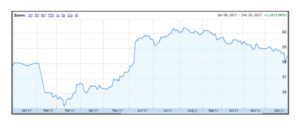
Figure 4: ICICI Prudential Long-Term Gilt Fund
Below is a one-year graph of ICICI Prudential Income Plan. It showed volatility in the period where interest rates remained unchanged and increased in value in June when a 0.25% rate decrease was announced. Returns in 2017 were 5.03%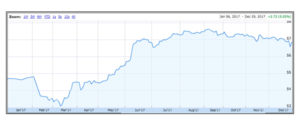
Figure 5: ICICI Prudential Income Plan
Below is a one-year graph of ICICI Prudential Dynamic Bond Fund. It showed volatility in the period where interest rates remained unchanged and increased in value in June when a 0.25% rate decrease was announced. Returns in 2017 were 4.66% 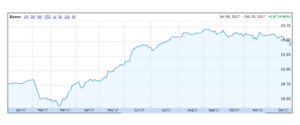
Figure 6: ICICI Prudential Dynamic Bond Fund
- Corporate bond funds: Corporate bond funds invest in corporate bonds of varying maturities that offer higher interest rates along with higher volatility and credit risk. The maturity for these bonds are medium to long term and hence higher exposure to interest rate risk than liquid, ultra-short and short-term debt funds.
Below is a one-year graph of ICICI Prudential Corporate Bond Fund. This was less volatile than the Gilt, Income and Dynamic Bond funds but marginally more volatile than the Short-Term Fund. Returns in 2017 were 6.52% 
Figure 7: ICICI Prudential Corporate Bond Fund
| ICICI Prudential MF | Tenure of securities | Returns in 2017 | Volatility (3yrBeta) | Risk |
| Liquid Fund | 1-3 months | 6.6% | 0.85 | Very Low |
| Ultra Short-term Fund | <1 year | 6.6% | 1.11 | Low |
| Short-term fund | 1-3 years | 5.9% | 1.56 | Low |
| Income Fund | 1-3 years | 5.0% | 1.54 | High |
| Dynamic Bond Fund | >3 years | 4.7% | 1.13 | Medium to High |
| Gilt Fund | > 3 years | 2.1% | 1.06 | Medium to High |
| Corporate Bond Fund | 1-3 years | 6.5% | 1.42 | Medium |
Conclusion
It is important to have some allocation of your portfolio to debt funds but choose the duration of the fund based on your risk appetite. It would be advisable to consult your independent financial advisor to seek the best course of action.
